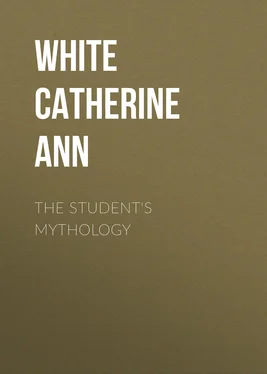Catherine White - The Student's Mythology
Здесь есть возможность читать онлайн «Catherine White - The Student's Mythology» — ознакомительный отрывок электронной книги совершенно бесплатно, а после прочтения отрывка купить полную версию. В некоторых случаях можно слушать аудио, скачать через торрент в формате fb2 и присутствует краткое содержание. Издательство: Иностранный паблик, Жанр: foreign_prose, foreign_religion, Философия, foreign_psychology, foreign_antique, на английском языке. Описание произведения, (предисловие) а так же отзывы посетителей доступны на портале библиотеки ЛибКат.
- Название:The Student's Mythology
- Автор:
- Издательство:Иностранный паблик
- Жанр:
- Год:неизвестен
- ISBN:нет данных
- Рейтинг книги:4 / 5. Голосов: 1
-
Избранное:Добавить в избранное
- Отзывы:
-
Ваша оценка:
- 80
- 1
- 2
- 3
- 4
- 5
The Student's Mythology: краткое содержание, описание и аннотация
Предлагаем к чтению аннотацию, описание, краткое содержание или предисловие (зависит от того, что написал сам автор книги «The Student's Mythology»). Если вы не нашли необходимую информацию о книге — напишите в комментариях, мы постараемся отыскать её.
The Student's Mythology — читать онлайн ознакомительный отрывок
Ниже представлен текст книги, разбитый по страницам. Система сохранения места последней прочитанной страницы, позволяет с удобством читать онлайн бесплатно книгу «The Student's Mythology», без необходимости каждый раз заново искать на чём Вы остановились. Поставьте закладку, и сможете в любой момент перейти на страницу, на которой закончили чтение.
Интервал:
Закладка:
The divinity worshipped by the Roman women under the name of Bona Dea, or Good Goddess, is believed to be the same as Cyb´ele.
Ancient writers relate an extraordinary incident connected with the arrival of the image of Cyb´ele in Rome. The ship which bore the sacred stone was stranded on a shoal in the Tiber. Claudia, a Vestal Virgin who was suspected of having violated her vow, attached her girdle to the prow, and drew the ship safely into port. Her innocence was established by this prodigy.
CHAPTER XVII
Ques. Who was Ceres?
Ans. She was the daughter of Saturn and Ops, and was worshipped as the goddess of fruits and corn. It is supposed that she first invented and taught the art of tilling the earth, and sowing wheat and other grains, so that men ate wholesome bread, where before they had lived on roots and acorns.
Ques. How is Ceres represented?
Ans. As a beautiful and majestic woman, with golden hair, and crowned with ears of wheat; in her right hand she holds poppies and ears of corn, and in her left, a flaming torch.
Ques. Explain these emblems.
Ans. The hair of Ceres is golden, to represent the color of ripe corn; she holds a lighted torch, because when her daughter Proser´pine was stolen by Pluto, Ceres kindled a torch from the flames of Mount Etna, to light her on her search throughout the world. She holds a poppy, because when she was so grieved that she could neither rest nor sleep, Jupiter gave her a poppy to eat.
Ques. Relate the story of Proser´pine (Perse´phone).
Ans. None of the goddesses were willing to marry Pluto, or share his gloomy kingdom. He determined, nevertheless, to obtain a wife, even if he had to do so by violence. Proser´pine, the daughter of Jupiter and Ceres, was gathering daffodils with her companions in the plains of Enna, when Pluto suddenly appeared among them in a chariot drawn by black horses. As the maidens fled in terror, he seized Proser´pine, and striking the waters of the fountain Cy´ane with his trident, he opened a passage, through which he descended with his prize. Ceres, ignorant of what had occurred, wandered through the world in search of her daughter. At length, arriving at the fountain of Cy´ane, she perceived the girdle of Proser´pine still floating on its waters; and the nymph Arethusa informed her of what had taken place. Ceres repaired immediately to Olympus, where she made her complaint to Jupiter, and demanded that Pluto should restore her daughter. Jupiter promised to grant her request, in case Proser´pine should not have tasted food in the infernal regions. Ceres descended thither, and Proser´pine prepared joyfully to accompany her mother, when Ascal´aphus reported that he had seen her eat some seeds of pomegranate. The hopes of Ceres were thus destroyed, but Proser´pine was so indignant at the treachery of Ascal´aphus, that she changed him immediately into an owl. Jupiter endeavored to appease the resentment of Ceres by permitting Proser´pine to divide the year, spending six months with her mother on earth, the other six with Pluto in the infernal regions.
Ques. What were the most famous solemnities instituted in honor of Ceres?
Ans. The Eleusian or Eleusinian Mysteries. They were named from Eleusis, a town in Greece where they were celebrated.
Ques. What rites were practiced during these mysteries?
Ans. We cannot tell with any certainty. The penalty of death was decreed against any one who should betray the secret, or even witness the ceremonies without having been regularly initiated. Disclosures were made, however, which seem to prove that the person to be initiated was first introduced into a dark subterranean cave, where he was terrified with the most fearful sights and sounds. After this, if his courage did not fail, he was suddenly introduced into a lovely garden, and the ceremonies concluded with feasting and dancing.
Ques. Who were admitted to these rites?
Ans. Athenians only; but Hercules, to whom no one dared refuse anything, was initiated, and after him, other distinguished foreigners were admitted to what were called the Lesser Mysteries. The Athenians were eager to be admitted to these rites, because they believed that the souls of those who had not been initiated were left to wallow in mud and filth in the lower regions.
Ques. What do the early Christian writers say of these mysteries?
Ans. They speak of them as being almost as immoral as the festivals held in honor of Bacchus.
Ques. Who is said to have instituted them?
Ans. Triptol´emus, the foster-child of Ceres.
Ques. Relate the story of Triptol´emus.
Ans. When Ceres was seeking Proser´pine by sea and land, she was kindly entertained by Celeus, king of Eleusis, in Attica. She rewarded his hospitality by taking care of his young son, whom she nourished during the day with celestial food; but in the night, she covered him with fire. Under this extraordinary treatment, the infant, in a few days, became a beautiful young man. His mother, Meganira, wondered at this, and resolved to discover the cause. She watched Ceres at night, and when she saw her covering Triptol´emus with living coals, she cried out in terror, and rushed into the room to save him. Ceres punished her curiosity with death, but she adopted Triptol´emus, and sent him through the world to teach mankind the use of corn. He executed the commands of Ceres, and wherever he went, instructed men in sowing, reaping, and other arts of husbandry. Triptol´emus is usually represented as a young man, seated in a splendid chariot drawn by flying serpents.
Ques. What sacrifices were offered to Ceres?
Ans. Young heifers, swine and ears of corn, wine, milk and honey were used in the libations.
Ques. What were the Ambarvalia?
Ans. They were feasts kept in the beginning of harvest, preparatory to reaping. The animal to be offered in sacrifice, was led around the fields, the husbandmen and country rustics following with shouts and songs. Virgil says of these festivities:
Let ev’ry swain adore her power divine,
And milk and honey mix with sparkling wine;
Let all the choir of clowns attend this show,
In long procession, shouting as they go;
Invoking her to bless their yearly stores,
Inviting plenty to their crowded floors.
Thus in the spring, and thus in summer’s heat,
Before the sickles touch the rip’ning wheat,
On Ceres call; and let the lab’ring hind
With oaken wreaths his hollow temples bind;
On Ceres let him call, and Ceres praise,
With uncouth dances, and with country-lays.
CHAPTER XVIII
Ques. Who was Themis?
Ans. She instructed both gods and men, and was generally considered the goddess of law and justice. Her origin is uncertain; but she is said to have been a Titaness.
Ques. Who was Astræ´a?
Ans. She was also goddess of justice; according to some, she was the daughter of Jupiter and Themis. When the Titans took up arms against Jupiter, Astræ´a descended to earth, and mingled with the human race. This intercourse was uninterrupted during the Golden Age; in the Silver Age, Astræ´a dwelt in the mountains, and descended only amid the shades of evening, when she was unseen by men. When the Brazen Age commenced, she fled altogether from the human race, being the last among the Immortals to abandon the earth. Jupiter then changed her into the constellation Virgo, one of the signs of the zodiac. This constellation is represented by the figure of a woman holding scales in one hand, and a sword in the other. The scales have been variously explained, but they are generally supposed to be an emblem of justice. According to some, Erigo´ne, a maiden who hung herself in despair, at the death of her father, was changed into the constellation Virgo.
Читать дальшеИнтервал:
Закладка:
Похожие книги на «The Student's Mythology»
Представляем Вашему вниманию похожие книги на «The Student's Mythology» списком для выбора. Мы отобрали схожую по названию и смыслу литературу в надежде предоставить читателям больше вариантов отыскать новые, интересные, ещё непрочитанные произведения.
Обсуждение, отзывы о книге «The Student's Mythology» и просто собственные мнения читателей. Оставьте ваши комментарии, напишите, что Вы думаете о произведении, его смысле или главных героях. Укажите что конкретно понравилось, а что нет, и почему Вы так считаете.












